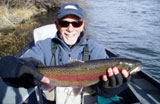Description
I�m glad to be back writing this column
again. Thanks to Paul Egan for stepping into
the breach and taking over for awhile�he did
a great job, and has graciously agreed to
back me up for those times when I am unable
to get an article done due to guiding
schedules or fly fishing travel.
For the next few months, I�m going to
feature some flies for the salt. Saltwater
fly fishing is a new twist that many fly
fishers are experiencing. For me the fly
fishing angle in salt water is relatively
new. I spent most of my non-fly fishing
youth prowling the surf, scrambling beneath
wharves, and wading among the rocks in
Monterey Bay looking for fish. So in a rough
sense I knew what to do when it came time to
cast a fly into inshore environments. I also
spent time on commercial fishing boats, so
offshore fishing was not new to me either.
But nothing prepared me for the thrill of
saltwater species grabbing my fly and making
my reel sing. Until you�ve experienced it,
it�s hard to imagine.
Some anglers become so enamored with the
salt that freshwater fishing falls by the
wayside. That�s not going to happen with
me�I couldn�t live without the surface take
of even a tiny trout, or seeing my line
hesitate as a fish takes my nymph, or
feeling the grab of my steelhead fly on the
swing. Nor can I imagine life without bass
and panfish, let along striped bass. So many
fish�so little time.
The Surf Candy is one of Bob Popovic�s many
legendary creations. You can find the Surf
Candy and other patterns in his book,
co-authored with Ed Jawoworski: Pop
Fleyes. Created in the late
1980�s, it represents baitfish. It can be
tied in various colors to imitate different
baitfish species. One common saltwater
species is the Sardina, found virtually
everywhere in Baja. The version in this
article is designed to represent a Sardina.
Incidentally, it can be used as a freshwater
baitfish for swinging streamers to big fall
browns, and even for bass.
Tying Instructions
|
-
Cover hook shank with thread
back to hook point; at that
point tie in a piece of
pearl mylar tinsel or braid.
Take thread to hook eye,
wrap the material forward
and tie off behind the eye.
-
Tie in a small bunch of
white synthetic hair behind
the eye; it should extend
about 5 hook lengths behind
the bend of the hook.
-
On top of the white, tie in
a small bunch of the grey
synthetic hair (same
length). Apply a drop of
super glue to hold these
slippery materials in place.
-
Tie in a small bunch of
pearl Crystal Flash (same
length). On top of that tie
in a small bunch of the
green synthetic hair.
-
The final touch is a small
bunch of the green/black
Crystal Flash. Tie this in
on the top to imitate the
dark back of the Sardina.
-
By now you should have a
relatively large, nicely
formed smooth head. Whip
finish and add a drop of
super glue to hold it all
together.
-
When the super glue is dry,
mix a small amount of
5-minute epoxy. Coat the
entire head and the part of
the body that is between the
head and the hook bend with
the epoxy. Use a generous
amount but turn the fly in
the vise constantly to
ensure an even distribution.
Pause during the turning
process and grab the end of
the body material and pull
directly rearward; this
gives the body a slender,
sleek appearance as the
epoxy dries. Alternate
pulling and turning for
about 4 or 5 minutes.
-
When the first coat is
almost completely dry (still
a bit tacky) stick on the
eyes, making sure that they
are placed in identical
positions on either side of
the head. Put pressure on
them by squeezing with your
thumb and forefinger.
-
Using a red Sharpie, make a
vertical mark just behind
the eyes to represent gills.
-
Apply another coat of epoxy;
this coat should be lighter
than the first, but should
thoroughly cover the eyes
and all of the rest of the
area covered by the first
coat.
-
Be sure to turn the fly in
your vise or on a fly turner
so ensure an even
distribution of the epoxy.
-
When the final coat is dry,
taper the ends of the body
so that it looks like a
swimming baitfish.
Tie this dude on a stout leader,
cast it to your favorite
saltwater species, and hold on!
|
|

